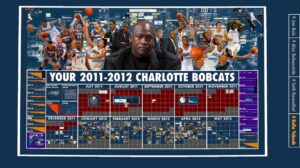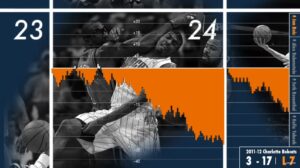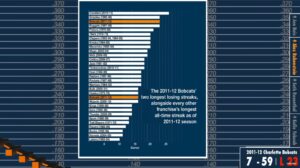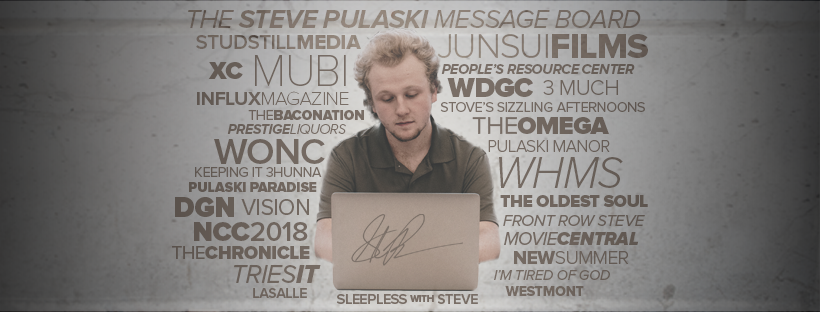Publication Date: 05-03-2025
The People You’re Paying to Be in Shorts (2022) review
Dir. Jon Bois
By: Steve Pulaski
Rating: ★★★★
There are a plethora of documentaries and books media dedicated to teams like the 2004 Boston Red Sox, the 1990s Chicago Bulls, and the dynastic New England Patriots. I’ve always been more interested in the perennial bottom dwellers of any given sport. I find the abysmal Cleveland Browns far more compelling than the Kansas City Chiefs, and I’d prefer if more sports debate shows would have bigger conversations about second-class teams such as the Washington Wizards than, say, for whom the Los Angeles Lakers can’t possibly trade.
That makes me the target demo for Secret Base, a sports media company run by Jon Bois. Whether Bois fully realizes it or not, he’s a pioneer in DIY filmmaking tactics, and as compelling a documentarian as you’ll find even in today’s vast media landscape. The People You’re Paying to Be in Shorts is a two-and-a-half-hour documentary concerning the worst team in NBA history: the 2011-12 Charlotte Bobcats. That sentence alone should tell you whether or not you want to dive-in headfirst or stay far, far away.

Bois — who has made several short-form videos on his Secret Base YouTube channel — plays the long-game by doing a deep-dive into futile, unsuccessful sports franchises. To employ a Kevin Smith analogy, he goes where the puck isn’t. After any championship, there is no shortage of press, beat writers, and countless alluring fans looking to bask in the glory. What about the also-rans? Those who fade off into the oblivion with no confetti, fanfare, or perceived mark on the sport?
In the case of the Charlotte Bobcats, most casual NBA fans probably forget they existed entirely. If this is your introduction to Bois and Secret Base, I’ll try and contextualize what you’re in for. This isn’t a talking-head driven documentary. Instead, Bois employs elaborate graphs, charts, statistics, newspaper clippings, and occasional bit of archival footage across a large, digital grid. The metaphorical camera transports the viewer all over said grid, carrying us from the squares of a calendar, to the annotated side panels, and more, bouncing us all around while narration from the likes of Bois, and fellow commentators, Alex Rubenstein, Seth Rosenthal, and Kofie Yeboah, tell the story. Their names are listed on the far-right side of the screen, highlighted in orange when the respective party is speaking, for clarity.

The canvas is built and developed the longer the film goes on. Background music comes in the form of the sweet sounds of Keith Mansfield, Alan Hawkshaw, and other smooth jazz musicians, a deliberate choice from Bois. Jazz stimulates the mind in a creative sense and often improves the focus of the listener.
Truth be told, there might not be a screen big enough to capture the density and specificity of Bois’ graphs, even if he likely optimizes these videos with iPhone viewing in mind.
Back to the 2011-12 Bobcats. The People You’re Paying to Be in Shorts spends the first half-hour cleanly explaining how the Charlotte Hornets were brought to the NBA as an expansion team in the 1980s by George Shinn. Overtime, Shinn became embroiled in one controversy after another, and controversially relocated the team to New Orleans, taking the Hornets name with him. The Charlotte NBA team was purchased by Robert Johnson, who, in true capitalistic fashion, decided to name the team the “Bobcats” after himself. The great Michael Jordan would assume operational control in 2006, effectively serving as the team’s general manager, and then became majority owner in 2010.

For the Bobcats’ first seven seasons, they were functionally mediocre. They belonged to the lower middle-class of the NBA, where no team wants to be: respectful enough not to be among the worst teams in the league, but not good enough to be a playoff threat. It didn’t help that every year, the Bobcats’ suboptimal draft picks led to them missing out on players like Dwight Howard, Kyrie Irving, and other future franchise-changers. Instead, they landed the likes of Kemba Walker, Gerald Henderson, D. J. Augustin, and Bismack Biyombo. A lot of solid role-players, none with the capability of lifting a team to new heights.
Following an NBA lockout — ignited by a small factions of hardline owners, Jordan being one of them — that shortened the season to 66 games, the 2011-12 Charlotte Bobcats entered the season with upper management looking to play a long-game. They avoided dolling out big contracts, kept their draft capital, and sought to escape the middle-of-the-road purgatory they had been in for so long. The team — featuring a who’s who of “who’s that?” roster of players, including Derrick Brown, Matt Carroll, and DeSagana Diop — went on to become the worst team in NBA history by win-percentage. The 2011-12 Bobcats recorded a win percentage of 10.6%, surpassing the 1972-73 Philadelphia 76ers’ 11%. The undersized, small-ball-centric Cats played their style of basketball with seemingly none of the inherent advantages and all of the perceived disadvantages, as Bois notes.
Bois’ film harbors exquisite attention to detail as it devotes significant time to more than half the games the Cats played that season. This is a project that was clearly researched to an exhaustive level. You’re witnessing hours upon hours of painstaking newsgathering unfold before your eyes.

The image of the doc that will be burned into your retinas by the end is the sad, teary-eyed visage of Michael Jordan, who exists front-and-center on Bois’ graphic, for he is mostly responsible for this mess. The People You’re Paying to Be in Shorts is a kind of anthesis to the mythmaking of Jordan brought on by now-multiple decades of intense debate and, of course, ESPN’s The Last Dance. This is a side of Jordan we never see: Jordan the failure. Forget the fact he never won meaningful games on the Bulls before the arrival of Scottie Pippen. Jordan remains a man of no patience, harboring intense competitive drive and a keep-up-or-fuck-off style of gamesmanship that makes him such an iconic athlete. At one point, Bois humorously surmises the possibility that Jordan mulled over a comeback, at 48-years-old, to suit up and play for the Cats. I’m willing to bet he did.
As the Bobcats’ season descends into darkness — the first 20 games results in them having a 3-17 record — a force begins to loom over the team, its presence a potential silver-lining in a campaign that was lost early. That force is Anthony Davis, a lengthy, dexterous big-man for the Kentucky Wildcats. He can do it all. It’s not even March Madness by the time Davis is the surefire number one overall pick in the forthcoming 2012 NBA Draft. He could be the savior for a Bobcats team in need of a leader, an odd thing to say about a 19-year-old. Charlotte fans have to laugh when they remember what came next.
Bois’ style also employs newspaper clippings in a way I’m not sure I’ve seen previously in any documentary yet. Most docs will clip headlines or ledes to contextualize events. Bois goes deeper, finding a telling quote from then-Bobcats head coach Paul Silas, in what appears to be paragraph seven of an article published by The Charlotte Observer. Doing so allows for threads to appear and the minutiae of the state of the team to reveal itself, such as locker-room confrontations between coach and players, changes in coaching strategies from Silas, and, most frequently, the ever-growing ennui of a team that is on a fast-track to being the worst team in the history of basketball.

As the final hour of The People You’re Paying to Be in Shorts commences, sad jazz music swells and shifts the tone from a comedy of errors to a sobering, humanizing portrait of abject failure. One aspect I didn’t expect (but wanted) was the credit bestowed upon Kwame Brown, one of the most unfairly maligned NBA players of his generation. Brown played for the 2010-11 Bobcats, and his interior defense and rebounding abilities, as Bois notes, were key ingredients missing on a team that was comparatively diminutive to the rest of the league. The embedded irony is that the 6’11” Brown — despite being broken down and browbeaten by Michael Jordan during his early NBA years with the Wizards — reunited with the GOAT when he owned the Bobcats. Brown was set to return for the 2011-12 Bobcats season, but received a larger offer from the Golden State Warriors. Though Brown probably didn’t intend for it, it was a glorious slap-in-the-face to the man largely responsible for his failure to live up to his status as a prep-to-pro player.
A point that Bois makes early in the documentary, and then near the end, is the Bobcats are a mostly forgotten team as a whole. The 2024 Chicago White Sox will be remembered. The 0-16 Cleveland Browns and winless Detroit Lions will forever be brought up regardless of the success either team goes on to have. Despite being a part of an NBA that loves celebrating their history, the new-look Charlotte Hornets will never have a “Bobcats” throwback night, nor will they ever conceive one of their alternate jerseys to resemble even remotely the milquetoast colors of a tumultuous team. The NBA would probably prefer you never utter the team name again.

If you’ve made it this far, The People You’re Paying to Be in Shorts is a film you need to watch. As someone who didn’t get fully invested into sports until their later teenage years, I’m grateful I did. Besides the lively meathead debates with my friends, and endless hours spent consuming media about why my favorite teams suck, I’ve learned that funneling my energy into sports pays more lucrative dividends than something like politics. Sports does what politics wishes it could do. And you don’t need a magnifying glass and a half-dozen off-the-record sources to get to the humanity of the people behind it; case-and-point, those who never set out to be the worst team in the history of the NBA.
NOTE: The People You’re Paying to Be in Shorts is available to watch on YouTube, free of charge.
Directed by: Jon Bois.
About Steve Pulaski
Steve Pulaski has been reviewing movies since 2009 for a barrage of different outlets. He graduated North Central College in 2018 and currently works as an on-air radio personality. He also hosts a weekly movie podcast called "Sleepless with Steve," dedicated to film and the film industry, on his YouTube channel. In addition to writing, he's a die-hard Chicago Bears fan and has two cats, appropriately named Siskel and Ebert!


